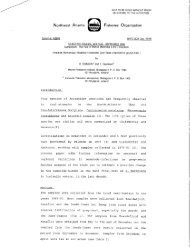Early Stages of Fishes in the Western North Atlantic Ocean Volume ...
Early Stages of Fishes in the Western North Atlantic Ocean Volume ...
Early Stages of Fishes in the Western North Atlantic Ocean Volume ...
Create successful ePaper yourself
Turn your PDF publications into a flip-book with our unique Google optimized e-Paper software.
x<br />
Historical background<br />
Introduction<br />
The early life history stages <strong>of</strong> fishes have <strong>in</strong>terested fisheries<br />
biologists and ichthyologists s<strong>in</strong>ce <strong>the</strong> days <strong>of</strong> Aristotle,<br />
who is <strong>of</strong>ten credited (albeit undeservedly) with <strong>the</strong> description<br />
<strong>of</strong> <strong>the</strong> leptocephalus <strong>of</strong> Anguilla. (Credit for <strong>the</strong> latter<br />
should be given to L.T. Gronovius, a.k.a. Gronow (1763) who<br />
published <strong>the</strong> first description <strong>of</strong> <strong>the</strong> eel's larva.) Dur<strong>in</strong>g <strong>the</strong><br />
ensu<strong>in</strong>g 250 years, <strong>the</strong> study <strong>of</strong> fishes' ontogeny has served<br />
as <strong>the</strong> basis for critical research <strong>in</strong>to population fluctuations<br />
<strong>of</strong> important species, as well as provid<strong>in</strong>g <strong>the</strong> basis for better<br />
understand<strong>in</strong>g systematic relationships among taxa. Studies<br />
<strong>of</strong> "modern" ichthyoplankton research can probably be traced<br />
back to <strong>the</strong> mid-1880s when a unique monitor<strong>in</strong>g program<br />
was <strong>in</strong>itiated along <strong>the</strong> Norwegian Skagerrak coast as a result<br />
<strong>of</strong> a controversy between <strong>the</strong> founder <strong>of</strong> <strong>the</strong> Flødevigen<br />
Mar<strong>in</strong>e Research Station, Gunder Mathiesen Dannevig<br />
(1841–1911), and <strong>the</strong> great pioneer <strong>in</strong> mar<strong>in</strong>e research, Johan<br />
Hjort (1869–1948). Dannevig argued for a determ<strong>in</strong>istic<br />
relationship between <strong>the</strong> number <strong>of</strong> yolk-sac codfish larvae<br />
and <strong>the</strong> number <strong>of</strong> recruits to <strong>the</strong> population, whereas Hjort<br />
argued that it was <strong>the</strong> environmental conditions dur<strong>in</strong>g <strong>the</strong><br />
critical phases <strong>of</strong> development which played <strong>the</strong> essential<br />
role <strong>in</strong> determ<strong>in</strong><strong>in</strong>g recruitment strength. Studies <strong>in</strong> <strong>the</strong> early<br />
21 st century cont<strong>in</strong>ue to exam<strong>in</strong>e <strong>the</strong> <strong>in</strong>terplay between <strong>the</strong>se<br />
concepts.<br />
In <strong>the</strong> western <strong>North</strong> <strong>Atlantic</strong> <strong>Ocean</strong>, a rich history <strong>of</strong><br />
studies on eggs and larvae <strong>of</strong> fishes exists, and this legacy<br />
<strong>in</strong>cludes a wealth <strong>of</strong> published records and pioneer<strong>in</strong>g research,<br />
much <strong>of</strong> which persists today. Cruises <strong>of</strong> <strong>the</strong> "Blake"<br />
and "Albatross" <strong>in</strong> <strong>the</strong> 1880s concentrated on adult stages<br />
(e.g. Goode and Bean, 1896), but also provided <strong>in</strong>formation<br />
on early stages <strong>of</strong> fishes <strong>in</strong> <strong>the</strong> western <strong>North</strong> <strong>Atlantic</strong>. S<strong>in</strong>ce<br />
<strong>the</strong>n, o<strong>the</strong>r government-sponsored expeditions have contributed<br />
a wealth <strong>of</strong> ontogenetic material, some <strong>of</strong> which has yet<br />
to be analyzed (Table 1).<br />
Gunder Mathiesen Dannevig's son Alf Dannevig published<br />
<strong>the</strong> results <strong>of</strong> an extensive survey <strong>of</strong> <strong>Atlantic</strong> Canada’s<br />
mar<strong>in</strong>e waters (1914–1915) and this study provided many<br />
early descriptions <strong>of</strong> larval fishes from this region (Dannevig,<br />
1919). Ano<strong>the</strong>r early study occurred <strong>in</strong> <strong>the</strong> 1920's when<br />
Oscar E. Sette and associates began an exhaustive study <strong>of</strong><br />
<strong>the</strong> early life history <strong>of</strong> Scomber scombrus (<strong>Atlantic</strong> mackerel).<br />
Workers <strong>in</strong>volved <strong>in</strong> this study may have focused on<br />
<strong>the</strong> mackerel, but <strong>the</strong>y also made an effort to identify all <strong>the</strong><br />
larval fishes (and some eggs) <strong>the</strong>y collected, leav<strong>in</strong>g beh<strong>in</strong>d<br />
an unpublished record <strong>of</strong> illustrations <strong>of</strong> larvae occurr<strong>in</strong>g <strong>in</strong><br />
<strong>the</strong> Gulf <strong>of</strong> Ma<strong>in</strong>e-Georges Bank region (Fig. 1 and 2). This<br />
collection <strong>of</strong> illustrations has been deposited <strong>in</strong> <strong>the</strong> United<br />
States National Museum and a selection is presented <strong>in</strong> Fig.<br />
3 and 4.<br />
Figure 1. Scomber scombrus preflexion larva, labeled "July 5,<br />
1928, 20249 Surface". Illustrator unknown, possibly<br />
O.E. Sette.<br />
Sette's studies (and draw<strong>in</strong>gs) were also <strong>the</strong> <strong>in</strong>spiration<br />
beh<strong>in</strong>d <strong>the</strong> publication <strong>of</strong> ano<strong>the</strong>r "larval fish guide" (Colton<br />
and Marak, 1969), a study focus<strong>in</strong>g on <strong>the</strong> Georges Bank-<br />
Gulf <strong>of</strong> Ma<strong>in</strong>e region, featur<strong>in</strong>g data on egg and larval development<br />
<strong>of</strong> 27 species. Sette was a reviewer <strong>of</strong> this atlas, prior<br />
to its publication as a technical report.<br />
Figure 2. Gadus morhua egg, labeled "20265 Surface Cod?" Illustration<br />
attributed to O.E. Sette.<br />
In order to use ichthyoplankton for fisheries, ecological<br />
or systematics research, it is obviously essential that eggs and<br />
larvae be correctly identified. Correct identification, <strong>in</strong> turn,<br />
relies on systematic analyses <strong>of</strong> characters which can only<br />
be undertaken after exam<strong>in</strong><strong>in</strong>g those characters <strong>in</strong> all related<br />
larvae <strong>of</strong> a group, whe<strong>the</strong>r at <strong>the</strong> level <strong>of</strong> genus, family or<br />
order, thus ga<strong>in</strong><strong>in</strong>g an appreciation for <strong>the</strong> value <strong>of</strong> certa<strong>in</strong><br />
characters. Although this dependence on correct identification<br />
appears to be an obvious requirement, a previous publication<br />
(Fahay, 1983) revealed several critical gaps <strong>in</strong> our<br />
knowledge <strong>of</strong> early stages, some <strong>of</strong> which <strong>in</strong>cluded commercially<br />
important taxa. The previous publication covered 255<br />
species <strong>in</strong> 92 families, likely to be collected <strong>in</strong> coastal waters<br />
<strong>of</strong> <strong>the</strong> western <strong>North</strong> <strong>Atlantic</strong> <strong>Ocean</strong> between Nova Scotia<br />
and Cape Hatteras. The present atlas covers <strong>the</strong> ontogeny <strong>of</strong><br />
760 species <strong>in</strong> 196 families. The <strong>in</strong>crease is due <strong>in</strong> part to an<br />
expanded study area, and <strong>in</strong> part to an <strong>in</strong>crease <strong>in</strong> ontogenetic<br />
studies, <strong>in</strong>spired to a certa<strong>in</strong> extent by <strong>the</strong> recent publication<br />
<strong>of</strong> several key studies.






